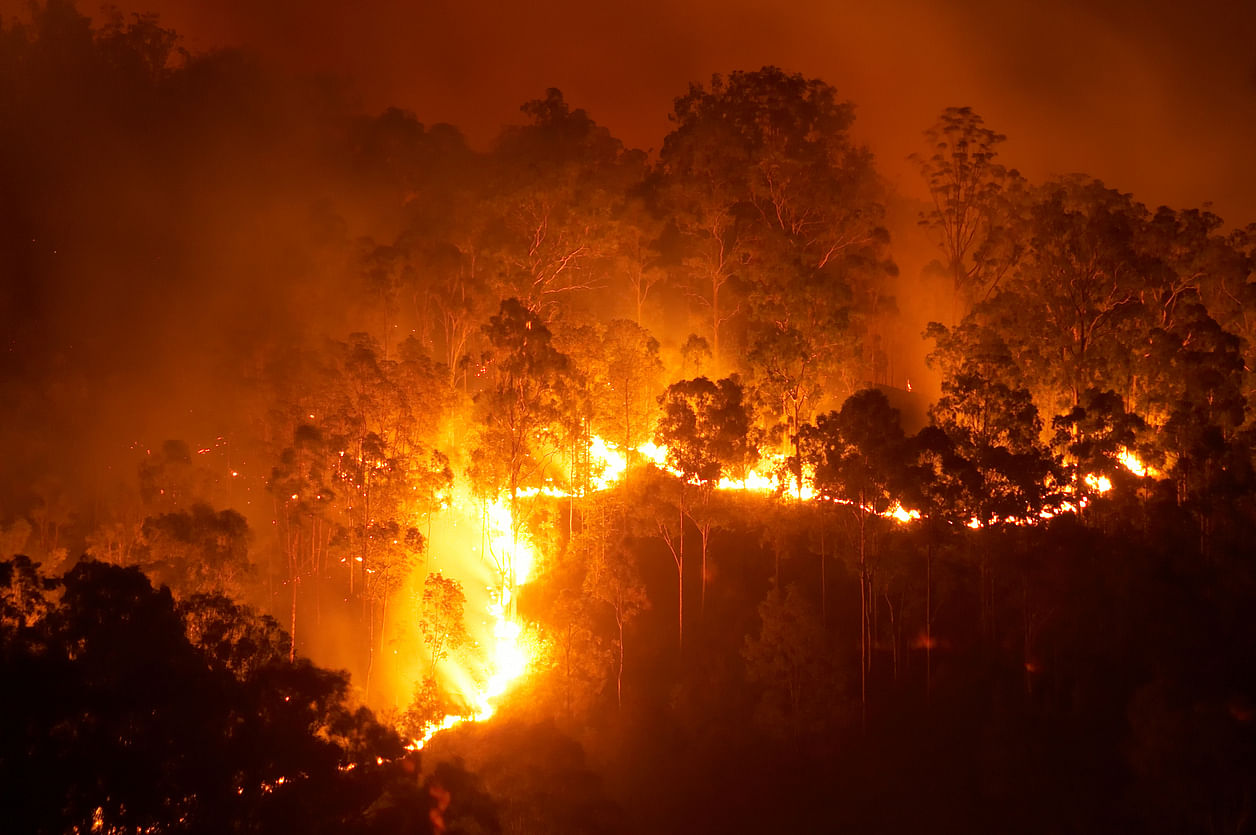
As recording-breaking wildfires continue to rage across the West, firefighters are confronting a new challenge that has snuck in under cover of darkness: rising nighttime temperatures.
Days and nights are both warming while heat-trapping greenhouse gases build up in the atmosphere, but scientists say nighttime increases are outpacing daytime rates. Since 2000 California’s daytime highs have been about 1.8 degrees Fahrenheit above the average for the previous 125 years, whereas overnight lows have been about 2.6 degrees F higher for the same period, says Tim Brown, director of the Western Regional Climate Center in Reno, Nev. “It’s a significant difference, with potential serious consequences for wildfires and those who combat them,” he says.
Firefighting crews wielding shovels and chain saws have traditionally worked at night to build fuel breaks, strips of land where flammable vegetation is removed. Flames that once reliably dwindled just after sundown are now remaining startlingly active and aggressive, however. For example, in the 319,000-acre North Complex fire that is still burning in northeastern California, a blaze advancing toward a rural community one night in August slackened close to midnight. But three hours later trees suddenly burst into flames—“one here, small groups there, crown fires torching off in the middle of the night. We’re not used to seeing that,” says Jonathan Pangburn, a forester and fire behavior analyst at the California Department of Forestry and Fire Protection.
Climate change, forest management and a century of intensive fire suppression are all contributing to the West’s wildfires, which have already burned an area nearly the size of Massachusetts and killed dozens of people in California, Oregon, Colorado and Washington State this year. The 192,560-acre East Troublesome fire, Colorado’s second largest in history, calmed on Monday, thanks to two feet of fresh snow, which hampered access for firefighters. In California, 361,000 customers were without electricity after the Pacific Gas and Electric Company shut off power as a precautionary measure against fires started by winds, which gusted up to 106 miles per hour on Sunday. Pangburn and other experts say largely unheralded warmer nighttime temperatures are feeding the flames of most western fires by increasing the number of hours when dead trees, leaf litter and other forest fuels are primed to burn.
Summer days in the West are typically warm and arid, allowing fuels to dry out and burn hot. But as temperatures cool at night, humidity increases. Dead trees and other materials absorb this water to balance their moisture levels and stay in equilibrium with the atmosphere, making it more difficult for them to burn. Firefighters have based their suppression strategies on this cycle, attacking flames harder at night to get ahead of the daytime drying. Working with headlamps, they clear trees and brush from wide lanes in forests. They also sometimes set small, controlled fires in front of advancing flames to consume fuels while things are less volatile and the flames are easier to manage.
In recent years, however, wildfires have been frustrating these tactics. Ryan Bauer, a Plumas National Forest firefighter with 24 years of experience, watched as the Claremont fire in northeastern California flared one August morning, “spreading and hooking around, making new runs across all our control lines,” he says. The flames raced down a canyon hours before the heat of midafternoon, when fires would typically grow and spread. “When you don’t get a cooldown at night or humidity recovery,” Bauer says, “it just keeps drying the fuels all night long.”
Scientists explain the increasing evening heat by pointing to the section of the atmosphere called the boundary layer, which sits just above the ground. This layer expands during the day as temperatures rise (because hotter air expands), and it contracts at night as they cool. For every excess bit of heat carbon dioxide and other greenhouse gases trap in the atmosphere, the shallower nighttime layer will warm faster than the deeper daytime one, according to a 2016 study published in the International Journal of Climatology by climate scientist Richard Davy of the Nansen Environmental and Remote Sensing Center in Norway and his colleagues.
University of Exeter scientists studying worldwide temperatures from 1983 to 2017 found an average difference of nearly 0.5 degree F between daytime and nighttime warming. In California, analyses by Brown found that overnight lows have increased about 0.3 degree F per decade since 1900. Since 2000, however, the trend has accelerated to 0.7 degree F per decade. This is one symptom of a warming world, says Deke Arndt, a climate scientist at the National Oceanic and Atmospheric Administration.
Such changes also hit human communities in a more direct way. Public health consequences extend beyond the smoke and danger of wildfires because lower-income and elderly individuals are more sensitive to a loss of ability to recover from a scorching day in the cool of night. Warmer nights also mean more people are running air conditioning at higher levels for more hours, consuming more energy. “An overnight low of 81 [degrees F] is not as sexy as an afternoon high of 106,” Arndt says. “But it can, in a systemic way, affect the health of our economy and people.”
Firefighters do have some options for adapting tactics to warmer nights—yet they are limited, Bauer says. Many of those battling this year’s intense fires have focused their attacks on the sides of advancing blazes instead of the more aggressive fronts, for example. Still, Pangburn notes, out-of-control fires will continue to be pumped up by changes in wind and precipitation and by higher temperatures—at both night and day. “Until we learn to live with fire in this changing climate scenario,” he says, “this is our new normal.”